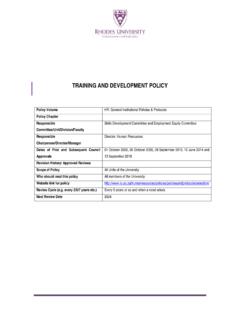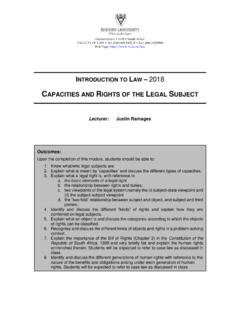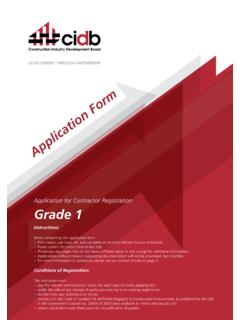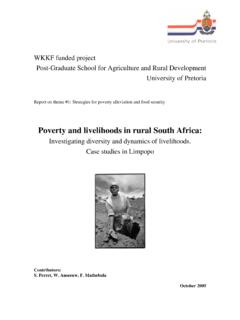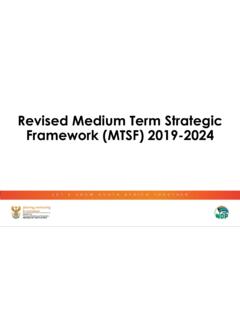Transcription of Teaching and Learning with Technology - Rhodes University
1 And Learning with Technology : Reframing traditional understandings and practicesTeaching and Learning with Technology : Reframing traditional understandings and practicesCase Studies: Tracey Flemming; James Gambiza; Chris Upfold; Mark de Vos; Maxine Diemer; Carol Thomson; Pedro Tabensky; Paul Wessels; Jen Snowball; Andrew Todd; Sioux McKenna; Kevin Barnard; Mutsa Chinyamakobvu; Hans-Peter Bakker; Sunitha Srinivas; Steffen B ttner; Sally Hunt; Kirstin KraussEditor: Nompilo TshumaCover photo: Nompilo Tshuma, edited using WordFoto2016 CONTENTSINTRODUCTION 4 Techonology and Transformation 4 What is TPACK 4 Context 5 Curriculum 5 Technology 5 Conclusion 5 CASE STUDIES Podcasting to improve students reading of academic texts 7 Self-directed knowledge creation using glossaries 9 Connecting virtually with industry experts 11 Developing student writing through peer review 13 Using videos for deep engagement 15 Encouraging collaboration through online reading groups 17 Using student-generated content to improve participation in a large class 19 Encouraging participation through social media 21 Building a doctoral community of practice 23
2 Enriching students background knowledge through Just-In-Time Learning 25 Using video lectures to build statistical research skills 27 An integrated system to scaffold student Learning 29 Using Skype to connect students with international change agents 31 Students Learning at their own pace 33 Collaborative peer feedback 35 Engaging students using a flipped classroom 37 Using questionnaires to grow a body of knowledge 39 Teaching and Learning with Technology : Reframing traditional understandings and practices4 CHERTL | Teaching and Learning with Technology IntroductionThe proliferation of online and institutional technologies has given them a perva-sive and elevated status in higher education. However, despite the belief by many that Technology can transform Teaching and Learning , its use is still mainly low-level: uploading lecture resources and keeping track of student assignment submissions.
3 In the high-pressured and performance-based University environment, not all lecturers are able to find the time to explore the potential of educational Technology to engage students while enhancing Learning , assessment of students work, and evaluation of Teaching and Nompilo TshumaThis publication is a collection of case studies outlining exam-ples of how lecturers at Rhodes University have carefully con-sidered and selected technologies to address a range of teach-ing and Learning challenges. In each case, the selection of the Learning Technology has been driven by a particular learn-ing challenge, with student engagement and enhancement of Learning as the main goals. The lecturers have utilised technol-ogy as one of several tools in the Learning process.
4 Each case study emphasises that even with students technological abili-ties and the masses of information readily available online, the teacher is still indispensable (Laurillard, 2013) for planning, facilitating, guiding and scaffolding Learning with Technology . For the sake of clarity, some of the details in the case studies may have been omitted or slightly and transformationTechnology has ubiquitously invaded the academic, business, government and private spheres. It has transformed some would say revolutionised the way we do business, communicate, work and manage our personal lives. It is now easier and faster to purchase airline tickets online, find research literature, communicate instantly with people across the globe and manage our daily , this transformation through the use of Technology tools has not had the same far-reaching and sustainable effect on higher education.
5 Instead, there have been isolated pockets of success and good practice, low-level and often administrative usage, as well as the lack of an educational rationale in most educational Technology integrations (Conole & Culver, 2010; Kirkwood & Price, 2014; Selwyn, 2014). The range of names used to refer to the field Teaching with Technology , digital Learning , Technology -enhanced Learning , computer-mediated Learning , e- Learning , and many others are evidence of the complex and contested nature of the South African higher education, the challenges of educational Technology use are further compounded by its economic status as a developing country, as well as the the damaging legacy of colonialism and apartheid (Grant, 2014, p.)
6 522). This legacy , which threatens to impede the effective and sustainable use of educational Technology , is evidenced by poor internet access in some universities, scarce educational Technology support expertise, the lofty aspiration to use educational Technology to open up access for previously marginalised groups (Ssekakubo, Suleman, & Marsden, 2011) and a lack of an educational Technology policy at the national level (Czerniewicz, Ravjee, & Mlitwa, 2006).How do we move beyond these challenges? How can we, in a volatile higher education environment that is struggling to come to grips with transforming an oppressive system, move beyond using Technology as an incidental adjunct (Pratt, 2014, p.
7 89) that perpetuates the existing power dynamics? How do we cater for an increasingly diverse student population with varying levels of technological ability, while overcoming our fear and frustration with technologies that become obsolete as quickly as they arrive (Mishra, Koehler, & Henriksen, 2011, p. 23)?A possible first step is to recognise that although technological skills are important, we need to go beyond these and begin to understand Technology s affordances and constraints both for representing content and identifying pertinent Teaching approaches (Mishra, Koehler, & Henriksen, 2011, p. 23). We also need to critically reflect on the constraints of our context and the historical legacies that may be perpetuating past inequities through the use of Technology in our and Koehler s (2006) TPACK framework offers a useful model to guide the interrogation of some of these elements in the educational Technology integration is TPACK?
8 Technological Pedagogical and Content Knowledge (TPACK) is a framework that outlines the different types of knowledge a teacher needs in order to successfully integrate Technology into Teaching . It was developed by Mishra and Koehler (2006) as an extension to Shulman s PCK framework (which excluded Technology knowledge). As shown in Figure 1 below, TPACK involves the integration of knowledge of student Learning , knowledge of the subject matter, and increasingly, knowledge of Technology Pedagogic Knowledge, Content Knowledge Teaching and Learning with Technology |CHERTL 5and Technology Knowledge, respectively (Mishra, Koehler, & Henriksen, 2011, p.)
9 23). The interaction and intersection of the three areas of knowledge takes place within a particular 1: TPACK framework (source: )As indicated in Figure 1 above, the intersection of the three areas of knowledge in the TPACK framework results in seven different types of knowledge. Following is a brief discussion of how the main concepts of the framework, , Context, Content Knowledge, Pedagogic Knowledge and Technological Knowledge, are significant to educational Technology South African higher education context has recently been rocked by student protests calling for a transformation of the culture, curriculum and costs of being a student in higher education.
10 The protests were driven by the need to counter the effects of apartheid and colonial legacies and enable previously marginalised economic and racial groups to access higher education financially, epistemologically and socially. Considering its ubiquitous nature and widespread acceptance as a positive enhancement to Teaching , Technology has to be subservient to this , before integrating Technology into the curriculum, the first step should involve a critical reflection on the national, institutional and departmental contexts. This process will enable teachers to broadly understand the impact of South Africa s colonialist and apartheid legacy on higher education, the power dynamics at different levels (particularly in the classroom), and the (un)intended oppression of students.







